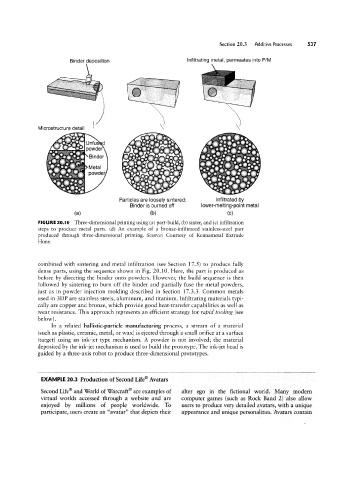Page 557 - 04. Subyek Engineering Materials - Manufacturing, Engineering and Technology SI 6th Edition - Serope Kalpakjian, Stephen Schmid (2009)
P. 557
,§;!i§§*¥* §¢
Q
powder
, get-3d.§§e2§Z@», 537
ii-eg; e~.;,,;';.¥;a1;
Additive Processes
Section 20.3
infiltrating metal, permeates into P/M
Binder deposition
Bidder
‘
\
\\
li/licrostructure detail is
Metal
powder ¥s#;4¥éE;dEd§='
*seed artist’
Particles are loosely sintered; infiltrated by
Binder is burned off lower-melting-point metal
(21) (bl (C)
FIGURE 20.|0 Three-dimensional printing using (a) part-build, (b) sinter, and (c) infiltration
steps to produce metal parts. (d) An example of a bronze-infiltrated stainless-steel part
produced through three-dimensional printing. Source: Courtesy of Kennametal Extrude
Hone.
combined with sintering and metal infiltration (see Section 17.5 ) to produce fully
dense parts, using the sequence shown in Fig. 20.10. Here, the part is produced as
before by directing the binder onto powders. However, the build sequence is then
followed by sintering to burn off the binder and partially fuse the metal powders,
just as in powder injection molding described in Section 17.33. Common metals
used in SDP are stainless steels, aluminum, and titanium. Infiltrating materials typi-
cally are copper and bronze, which provide good heat-transfer capabilities as well as
wear resistance. This approach represents an efficient strategy for rapid tooling (see
below).
In a related ballistic-particle manufacturing process, a stream of a material
(such as plastic, ceramic, metal, or wax) is ejected through a small orifice at a surface
(target) using an ink-jet type mechanism. A powder is not involved; the material
deposited by the ink-jet mechanism is used to build the prototype. The ink-jet head is
guided by a three-axis robot to produce three-dimensional prototypes.
EXAMPLE 20.3 Production of Second Life® Avatars
Second Life® and World of Warcraft® are examples of alter ego in the fictional world. Many modern
virtual worlds accessed through a website and are computer games (such as Rock Band 2) also allow
enjoyed by millions of people worldwide. To users to produce very detailed avatars, with a unique
participate, users create an “avatar” that depicts their appearance and unique personalities. Avatars contain

